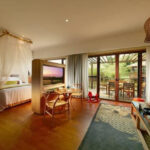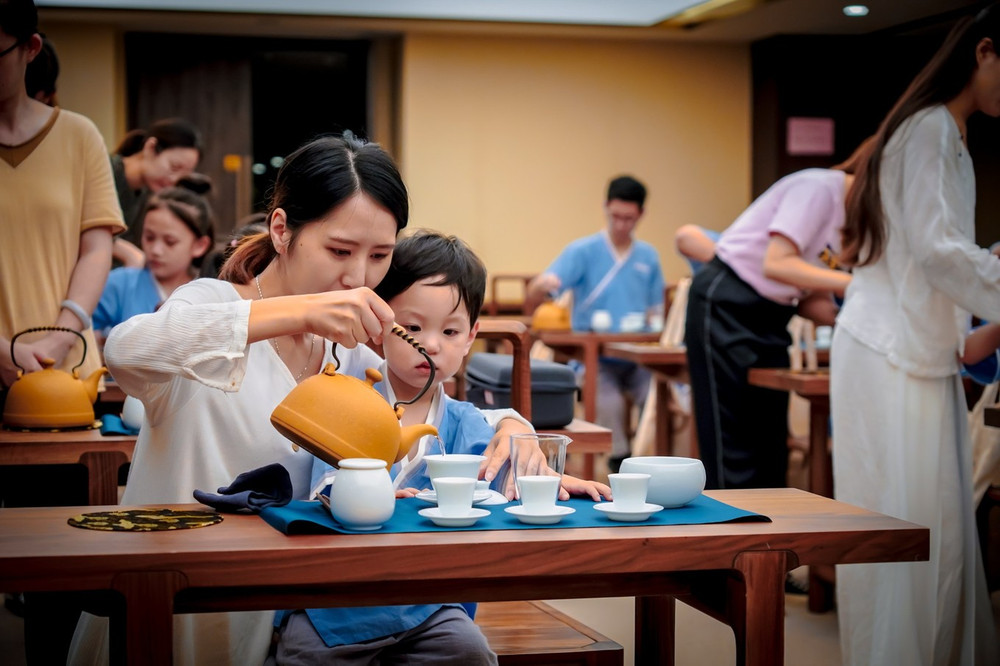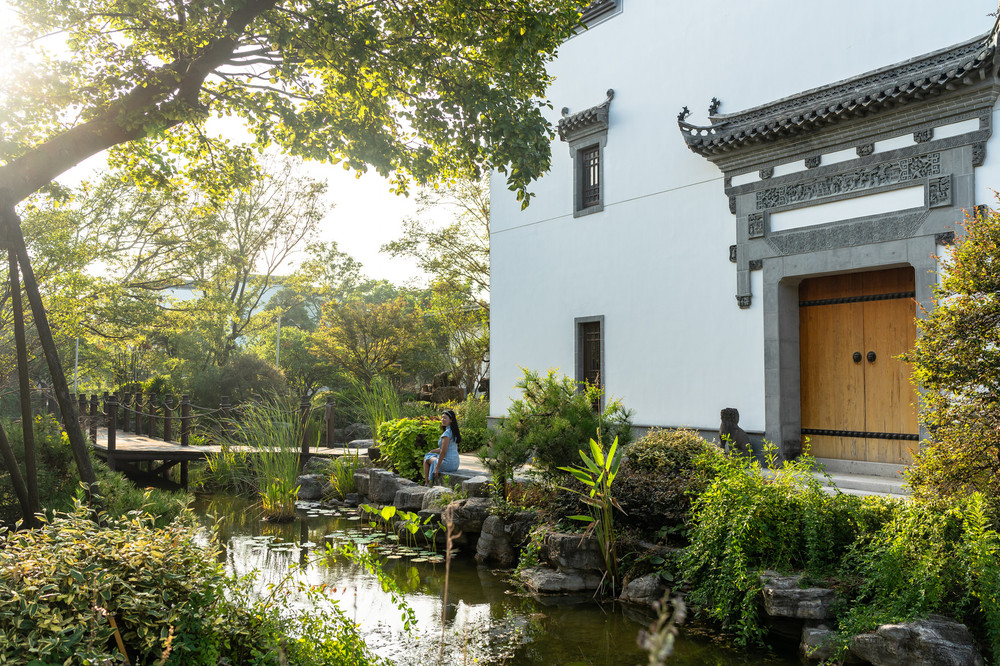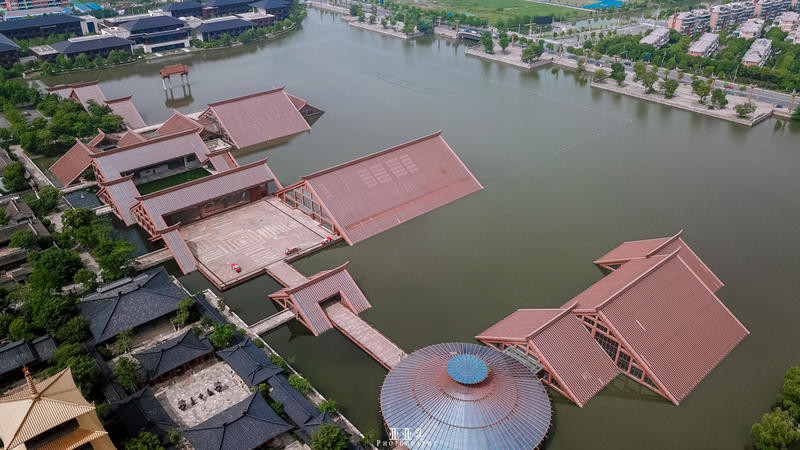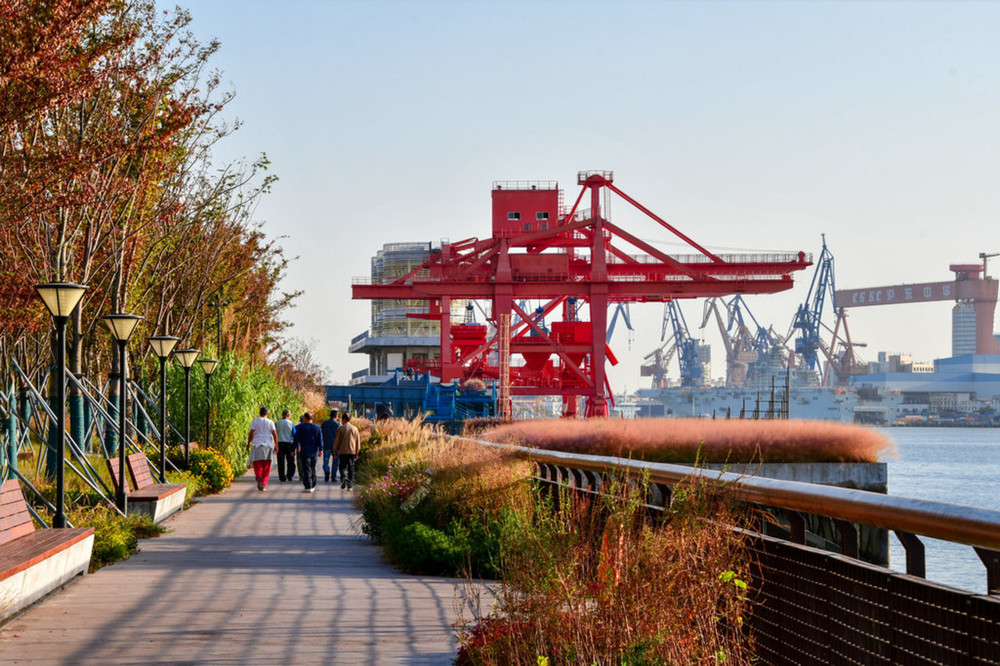Duration: 1 day
Time: January
Cost per person: 100 yuan
With whom: Spouse
Activities: Cultural, Free Travel
Author visited these places: Zhenru Temple, Shanghai Wanshou Temple, Square Pagoda, Zhenru Ancient Town.
Published on 2021-01-31 11:19.

Zhenru Temple is located at No. 399 Lanxi Road, Zhenru Town, Putuo District, Shanghai, covering an area of nearly 20 acres with a construction area of 1370 square meters. Originally named ‘Wanshou Temple’ and commonly referred to as ‘The Great Temple’, Zhenru Temple has been an ancient Zen temple for nearly seven hundred years since it was rebuilt by the monk Miaoxin in the seventh year of the Yuan Dynasty’s Yanyou era (1320). The temple was once thriving with incense, which gradually led to the development of the surrounding area into a market town, known as Zhenru Town, which continues to this day. Thus, it is said that Zhenru Temple came before Zhenru Town.
This Yuan Dynasty temple, expanded during the Ming Dynasty’s Hongwu and Hongzhi eras, once enjoyed great prosperity. During the Anti-Japanese War, the temple was destroyed, leaving only the main hall built in the Yuan Dynasty in a dilapidated state. The current temple, after multiple renovations and expansions, became a protected cultural site in Shanghai in 1959 and was promoted to the fourth batch of national key cultural protection units in 1996, officially opening in 1992.
The main beam in the middle of the main hall, inscribed with ‘In the great Yuan Dynasty, in the seventh year of Yanyou, during the Jiaxia month, on the 20th day of the Yiwei solar term, at the Xun hour,’ is said to be an inscription made at the time of the temple’s construction. This double-hooked intaglio inscription matches the documentary records, confirming that this seemingly ordinary small hall in Putuo District is the earliest existing wooden structure in Shanghai and also a precious early relic in Jiangnan.
Inside the temple, new structures such as the east-facing new mountain gate archway, Heavenly Kings Hall, Round Hall, Sutra Library, Buddha Recitation Hall, and Rebirth Hall have been built, and the old mountain gate (No. 15 Temple Front Street) across the river has been preserved with the wooden temple plaque hanging on the old mountain gate archway. On the left and right sides of the main gate, there are inscriptions of ‘Wuyuan Jietuo’ and ‘Wuxiang Jietuo.’ The new Buddha Recitation Hall is ingeniously connected to the east wing room by an overhead building, forming a harmonious whole. All buildings are based on the style of the Yuan Dynasty’s main hall, with a uniform style of green tiles and white walls, single eave hip roofs, and dragon head ridge styles. All decorations are primarily based on natural wood product structures. The entire complex of buildings features upturned eaves and corners, exuding a simple and dignified atmosphere.
The main hall of Zhenru Temple, built in the Yuan Dynasty, has a width and depth of three bays, with a very complex internal structure that has been renovated many times throughout the generations. During the Hongwu years of the Ming Dynasty (1368-1398), the monk Daoxin, and during the Hongzhi years (1488-1505), the monk Falei, renovated the temple twice. In the 20th year of the Guangxu period (1894), Yang Yaowen, Gan Shilin, and others, along with monks Nian’an and Nianlun from Shanghai Shousheng Temple, jointly initiated a fundraising campaign to repair the temple, carrying out major repairs on the original main hall.
The existing main structures such as beams, columns, and arches, along with most of the components, are original Yuan Dynasty artifacts. Zhenru Temple is one of the few Buddhist temples in China that has preserved Yuan Dynasty architecture.
The first southern structure is a newly built Yuan-style Hall of the Heavenly Kings, which was completed in November 1993 and inaugurated in 1994. The Hall of the Heavenly Kings features a unique three-bay single-eave hip roof, named ‘Tusita Heaven’. Inside, a newly added bronze statue of Maitreya, clay sculptures of the Four Heavenly Kings and two figures of the Secret Traces Vajra (commonly known as ‘Heng Ha Er Jiang’), and a wooden carving of the deity Wei Tuo can be found.
Beyond the Hall of the Heavenly Kings lies the central courtyard of the temple, flanked by two ginkgo trees on either side. The western tree was planted by the founding monk andIn 1992, the Venerable Miaoling was entrusted to revive the temple. As the temple’s incense was rekindled, the ancient tree seemed to understand human nature, rejuvenated, and began to sprout new branches, demonstrating a miracle of Buddhism. The faithful spread the word, calling it the ‘Divine Tree’, and as more people came to pray and make wishes in front of the tree, it became known as the ‘Wishing Tree’. The Shanghai Ancient and Famous Trees Protection Stele, Ginkgo Tree No. 0067, 650 years old, under first-class protection.
Upon entering the inner courtyard, one can see the treasure of Zhenru Temple – the Yuan Dynasty Hall. It is one of the best-preserved Yuan Dynasty wooden structures in the Jiangnan region and the oldest existing wooden structure in Shanghai. It holds great historical value and is listed as a national cultural relic. The Yuan Dynasty Hall maintains the single-eave hip roof structure of the Yuan Dynasty. The ridges, corners, and other components of the hall’s roof are all drawn and restored according to the Yuan Dynasty architectural records.
In front of the Yuan Dynasty Hall, there is a Dragon Hall with a 1.2-meter-high circular blue stone lotus platform in the center of the Hall of Universal Compassion, with a vajra pillar at the waist of the lotus platform, accompanied by deep reliefs of the Eight Heavenly Dragons. On the lotus platform is a white marble four-faced Guanyin statue, 5.2 meters high and weighing 3.5 tons, which was invited from Singapore. The crown is sculpted with the Five Buddhas of the Five Directions, all carved from a single piece of jade, making it extremely precious. In the center of the checkerboard ceiling of the hall, the central well is in the shape of a thousand-armed and thousand-eyed Avalokitesvara, symbolizing the Bodhisattva’s ability to see with a thousand eyes and protect with a thousand hands, helping all beings. Around the well, there are wooden carvings of the thirty-two manifestations of Avalokitesvara as hanging inscriptions, forming a canopy.
The temple hall features walls adorned with diverse and vivid stone carvings of Avalokitesvara Bodhisattva and his twenty-eight entourage. Above, there is a stele inscribed with Zhao Puchu’s ‘Avalokitesvara’s Universal Gate Chapter’.
Behind the Round Wisdom Hall stands the Zhenru Pagoda Courtyard, which houses a 51-meter tall nine-tiered square pagoda in the style of the Song and Yuan dynasties. The pagoda, with its dignified and towering presence, is truly spectacular. The construction of the pagoda began in September 1998 and was completed in thirteen months. On December 24, 1999, the Zhenru Temple held a grand ceremony to mark the completion of the Zhenru Pagoda. The style of the pagoda harmoniously complements the temple’s architecture, enhancing the temple’s appearance with a finishing touch and adding a landmark to the tourism, commerce, and community of Zhenru Ancient Town. The Zhenru Pagoda consists of nine external levels, ten internal levels, and an underground palace, making a total of eleven levels. Zhenru Temple is one of the earliest temples in Shanghai to enshrine the true body relics of Buddha. On November 14, 2004, the Venerable Miao Ling and others personally went to Pudong International Airport to welcome the Buddha’s true body relics into the temple and enshrine them in the underground palace of the pagoda. An article dedicated to the Zhenru Pagoda describes it as: ‘The majestic Zhenru Pagoda, like a dragon soaring through the clouds. The two black marble pieces in the lotus pond represent the dragon’s eyes, the sutra pillars are its whiskers, the two osmanthus trees are its horns, the pagoda itself is the dragon’s body, and the cloud-like path in front of the pagoda symbolizes the dragon scales.’ On both sides of the steps leading to the platform, there are eight exquisitely carved Tang-style stone lamps, each 3.5 meters tall, encircling the pagoda. In front of the pagoda, there are two bluestone steles erected in 2002 (the eighth day of the fourth lunar month in the year of Renwu). The left one is the ‘Zhenru Pagoda Inscription’ and the right one is the ‘Renovation of Zhenru Temple Inscription’. Surrounding the square pagoda, there is a circle of 108 prayer wheels, which, when turned clockwise, are believed to invoke the blessings of the Bodhisattva for good fortune. The lion figures beside the pagoda serve as its guardians. Beneath the Zhenru Pagoda, there are a total of 108 prayer wheels.The entire Scripture Pavilion features natural wood doors, windows, and railings, which add to its solemnity. Flanking the Hall of the Heavenly Kings, the two-story Bell Tower and Drum Tower extend northward. To the east of the Bell Tower are the Hall of the Earth Store Bodhisattva, the Hall of Manjushri, the Hall of the Medicine Buddha, the Chanting Hall, and the eastern corridor. To the west of the Drum Tower are the Hall of the Guardian Deities, the Hall of Samantabhadra, the Hall of the Guide to the Pure Land, and the meditation hall.
To the west of the main building of Zhenru Temple, along the east bank of Taopu River, there is a 200-meter-long wooden calligraphy and painting stele corridor. In the northern section of the corridor, there are variously shaped steles inlaid in an orderly manner, including pagoda-style, inset screen-style, drum-style, stupa-style, and screen-style steles, which are diverse and rich in Buddhist charm. The selection of stele carving topics combs through the millennium context of Buddhism and chooses the essence as the theme, combined with the handwriting of many famous masters in ancient and modern times, which has high ornamental value of Buddhist culture and art. Newly built stele corridors are rare nowadays, except for ancient stele corridors, indicating that the abbot is discerning. Inside the corridor eaves, there are various contemporary Zen calligraphy and painting works. This Buddhist culture corridor is a major highlight of Zhenru Temple. In the southern section of the corridor, there are 13 ancient bells from the Wanli period of the Ming Dynasty to the Republic of China arranged in a row.
The pigeons in the temple are the most spiritual. They can understand what you say. If they fly in front of you, it proves that you are a kind-hearted person. Here is an irregular strip-shaped area with a carefully designed Zen garden with rockeries, flowing water, curved bridges, spherical seats, flower racks and a release pond. The entire landscape represents a harmonious and perfect artistic conception.
To the north of Zhenru Temple, a corridor building is built along Taopu River. At the junction of Taopu River and Liyuanbang, Zhenru Bridge is built. Zhenru Temple is located in a busy area but appears peaceful. For pilgrims who like tranquility, this is a blessed place. Zhenru Temple is one of the four famous temples in Shanghai (Jing’an, Longhua, Jade Buddha…). Zhenru Temple is clean and elegant, with pleasant scenery, clusters of trees, and green grass like a carpet. It is far from the hustle and bustle of the city and is a rare peaceful place.

